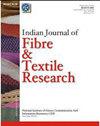Wear, morphological and thermal behavior of flax fibre reinforced epoxy composites
IF 0.6
4区 工程技术
Q4 MATERIALS SCIENCE, TEXTILES
引用次数: 0
Abstract
Effect of different types of chemical treatments, viz. alkali (NaOH) treatment, trimethoxymethylsilane(Silane) treatment,and combination of both alkali and silane treatment on structural and thermal properties of flax fibres has been investigated bymeans of scanning electron microscopy (SEM), X-Ray diffraction and thermogravimetric (TGA) analysis. Besides, flax fibrereinforced epoxy composites (FFRECs) comprising 45wt.% of fibre reinforcement have been subjected to multi-pass drysliding wear test and experimental runs are conducted as per Taguchi design of experiment technique. Crystallinity index (CI)value of 54.85 is found for alkali-cum-silane (AST) treated fibre, which is 39.23 % and 29.79 % higher than that of untreated(UT) fibre and silane treated (ST) fibre respectively. However, a very mere difference in CI values is observed between alkalitreated (AT) and AST fibres. TGA study shows that UT fibre is thermally stable up to 240°C and this stability is enhanced to310°C owing to chemical alteration as exhibited by AST fibre. Microhardness test indicates minor improvement in the hardnessproperty of the treated FFRECs over the untreated composites. Wear test results reveal that chemically modified FFRECs offerbetter wear resistance than untreated FFRECs and the mechanisms endured by the composites are exposed by SEM. Amongstthe prepared FFRECs, silane-treated FFREC exhibits better wear resistance property. Furthermore, the findings of analysis ofvariance (ANOVA) show that applied load and sliding distance contribute significantly to wear volume loss of FFRECs.亚麻纤维增强环氧复合材料的磨损、形态和热行为
采用扫描电镜(SEM)、x射线衍射和热重分析(TGA)等方法研究了碱(NaOH)处理、三甲氧基甲基硅烷(Silane)处理和碱硅烷复合处理对亚麻纤维结构和热性能的影响。此外,亚麻纤维增强环氧复合材料(FFRECs)含有45wt。对%的纤维增强材料进行了多道次的干滑磨损试验,并按田口设计的试验技术进行了试验运行。经碱-硅烷(AST)处理的纤维结晶度指数(CI)为54.85,分别比未处理(UT)和硅烷处理(ST)的纤维高39.23%和29.79%。然而,在碱处理(AT)和AST纤维之间观察到的CI值只有非常微小的差异。TGA研究表明,UT纤维在240°C前具有热稳定性,AST纤维在310°C时由于化学变化而增强了这种稳定性。显微硬度测试表明,处理后的FFRECs的硬度性能比未处理的复合材料有轻微的改善。磨损试验结果表明,化学改性的FFRECs比未经处理的FFRECs具有更好的耐磨性,并通过扫描电镜揭示了复合材料的耐磨性机制。在所制备的FFRECs中,硅烷处理的FFRECs具有较好的耐磨性。此外,方差分析(ANOVA)的结果表明,施加载荷和滑动距离对FFRECs的磨损体积损失有显著影响。
本文章由计算机程序翻译,如有差异,请以英文原文为准。
求助全文
约1分钟内获得全文
求助全文
来源期刊

Indian Journal of Fibre & Textile Research
MATERIALS SCIENCE, TEXTILES-
CiteScore
1.20
自引率
0.00%
发文量
43
审稿时长
6-12 weeks
期刊介绍:
Started in 1976, this journal publishes papers on both fundamental and applied research in various branches of textile technology and allied areas such as Production and properties of natural and synthetic fibres (including industrial fibres), yarns and fabrics; Physics and chemistry of fibre forming polymers; Chemical and finishing processes; Fibre-reinforced composites; Garment technology; Analysis, testing and quality control; Application of microprocessors; Instrumentation; application of nanotechnology in textiles; and Industrial engineering.
 求助内容:
求助内容: 应助结果提醒方式:
应助结果提醒方式:


